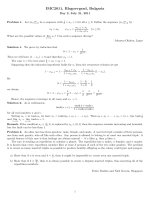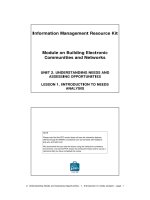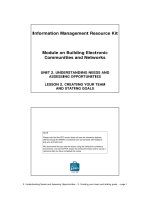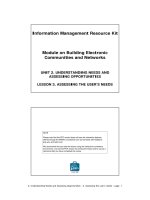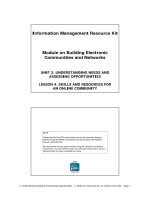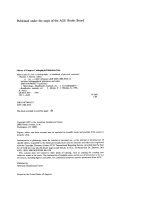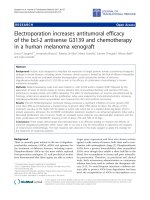Day 2 2 acidizing placement and diversion techniques final
Bạn đang xem bản rút gọn của tài liệu. Xem và tải ngay bản đầy đủ của tài liệu tại đây (10.06 MB, 52 trang )
Day 2: Acidizing placement and diversion
techniques
Diversion, Pumping Schedule &
Placement defini9ons
Engineering a good matrix acid job the treatment
effectiveness depends on getting the fluids where
they’re supposed to go
! Diversion ‐ methods and materials to appropriately distribute
fluids across the treatment interval
! Pumping Schedule ‐ injection method and rates to efficiently
place fluids
! Placement ‐ calculated end effect of combining fluid stages,
diversion and pumping on formation interval
Placement and diversion
! Placement refers to the way the stimulation fluids
are introduced in the well
! Diversion is about the ways to distribute the
fluids across the target zone.
Diversion, Pumping Schedule &
Placement
Purpose of Diversion
! Achieve uniform damage removal
! Distribute flow across the treated interval
! Alter flow path to prevent treatment fluids from
being disproportionately injected into high‐
perm zones
Placement and Diversion
Diversion and placement philosophy
! The length of the interval to be treated.
! Whether it is more or less homogeneous.
! Do we want to steer away from water bearing
intervals?
! What is the completion type; i.e.open hole,
perforated casing, slotted liner, etc?
! Bottom hole temperature
! Wellbore deviation and
! Reservoir type and fluid
Maximum Pump Rate
Without Fracturing
Diversion, Pumping Schedule &
Placement
10000
Injectivity (m3/d/m)
1000
100
10
1
1
10
10 mD
100 mD
dP (Bar)
100
1000 mD
10,000 mD
Acid Placement in Heterogeneous
Forma9ons
High Skin
Thief
Zone
Low Skin
High Skin
Thief
Zone
Low Skin
Plain HCl
< 1 cp
Emulsified HCl
> 20 cp
Example case for placement & Diversion
4 zones of different permeability
Example Well
Bottom Hole Static Temperature:
Drainage Radius:
Kvertical/Khorizontal:
Reservoir Pressure Gradient:
Pressure at .:
Calcite/Total Carbonate Ratio:
HCl Solubility:
Top Measured Depth:
Bottom Measured Depth:
Average Deviation:
Average Pressure:
Average Skin:
Average Permeability:
Effective Zone Height:
Effective Top MD:
Effective Bottom MD:
91 °C
1000.0 m
0.10
0.0705 bar/m
0.0 bar
41.18 %
85.00 %
3726.0 m
3765.0 m
65.5 °
188.7 bar
16.32
87.2 md
28.5 m
3729.0 m
3764.0 m
Interval Reservoir Data
Name!
zone 1
zone 2
zone 3
zone 4
Top
Bottom
Meas. Meas.
Depth Depth
(m)!
(m)!
3726.0
3736.0
3746.0
3757.0
3735.0
3745.0
3756.0
3765.0
Reservoir
Perm Porosity Pressure Inflow Skin! Type
(md)! (%)!
(bar)!
(%)!
50.0
10.0
100.0
200.0
188.2
188.5
188.7
189.1
28.00
10.00
2.00
60.00
11.00
10.00
10.00
12.00
Mineralogy Data
Mineral!
Anhydrite
Calcite
Dolomite
zone 3 at
3752.0 m!
Average %
Content for Well1!
15.0
35.0
50.0
15.0
35.0
50.0
4.08
‐1.57
390.46
12.54
Carbonate
Carbonate
Carbonate
Carbonate
Interval Reservoir Data
Name!
zone 1
zone 2
zone 3
zone 4
Top
Bottom
Meas. Meas.
Depth Depth
(m)!
(m)!
3726.0
3736.0
3746.0
3757.0
3735.0
3745.0
3756.0
3765.0
Reservoir
Perm Porosity Pressure Inflow Skin! Type
(md)! (%)!
(bar)!
(%)!
50.0
10.0
100.0
200.0
188.2
188.5
188.7
189.1
28.00
10.00
2.00
60.00
11.00
10.00
10.00
12.00
Mineralogy Data
Mineral!
Anhydrite
Calcite
Dolomite
zone 3 at
3752.0 m!
Average %
Content for Well1!
15.0
35.0
50.0
15.0
35.0
50.0
4.08
‐1.57
390.46
12.54
Carbonate
Carbonate
Carbonate
Carbonate
Base case – bullheading no diversion
High S zone
to be
acidised
Lower zone
takes most
acid
Placement
! Use of coiled tubing
! Spotting acid
! High rate and maximum pressure (Halliburton
terminology MAPDIR)
Placement
Coiled tubing (CT)
!
SpoΦng acid
Maximum rate Maximum pressure
Diversion
! Mechanical methods
! Ball Sealers
! Chemical Methods
! Particulates
! Viscous fluids
! Foams
! Visco‐elastic surfactants
! Two‐phase (relative permeability) effects
Diversion methods
! Mechanical techniques
! Packer and bridge plug arrangements
! Selective Placement Tool (SIP)
! Ballsealers
Diversion, Pumping Schedule &
Placement
Types of Diverter
! Ball Sealers
! Particulates
! Gels and Gelled Acids
! Cross‐linked Gel Slugs
! Foams
Diversion, Pumping Schedule &
Placement
Ball Sealers
! Only applicable for cased, cemented and
perforated completion
! Transported in treating fluids
! Preferentially seal on the perforations taking
most fluid
! Can lead to ballouts
! Can be designed to flow back or fall into the
rathole
Diversion, Pumping Schedule &
Placement
Ball Sealers ‐ Sea9ng
! The minimum ball seating flow rate is the flow
rate required to pull a single ball out of a fluid
stream
! The maximum number of perforations for
effective ball seating is in the range of 200‐250
total
Diversion, Pumping Schedule &
Placement
Ball Sealers in
Deviated and Horizontal Wells
! Efficiency depends on
! Hole angle
! Ball density
! Flow rate (velocity)
! Perforation orientation
! Permeability contrasts
! Number of perforations
Ballsealers
!
!
!
Diversion, Pumping Schedule &
Placement
Types of Diverter
! Ball Sealers
! Particulates
! Gels and Gelled Acids
! Cross‐linked Gel Slugs
! Foams

